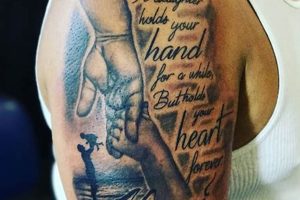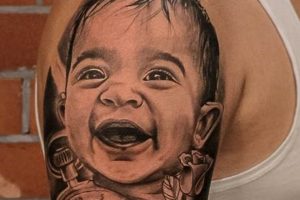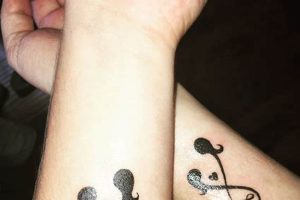Permanent body art chosen to represent the unique bond between a father and his daughter can take many forms. These designs can range from simple, shared symbols like hearts or infinity loops to more complex and personalized artwork incorporating elements meaningful to both individuals, such as birthdates, shared hobbies, or inside jokes. For example, a father and daughter might choose matching musical notes if they share a love of music, or matching compasses to symbolize their shared journey through life.
Such shared ink serves as a lasting testament to the enduring connection between fathers and daughters. It can be a powerful symbol of love, support, and shared memories, offering a visual reminder of their special relationship. While the practice of commemorative tattoos is ancient, the specific focus on familial bonds, particularly between fathers and daughters, has become increasingly popular in modern times. This rise in popularity reflects a broader cultural trend towards celebrating and expressing familial connections in visible and enduring ways.
This exploration will delve into the various facets of selecting meaningful designs, discuss important considerations such as placement and style, and offer inspiration through showcasing a range of popular and unique concepts.
Tips for Choosing Father-Daughter Tattoos
Careful consideration should be given to several factors before committing to permanent body art symbolizing a father-daughter relationship.
Tip 1: Collaborative Design: Designs should be chosen collaboratively, reflecting the preferences and tastes of both individuals. Open communication throughout the design process is crucial for a result both parties will cherish.
Tip 2: Meaningful Symbolism: Opt for imagery that holds genuine significance for both the father and daughter. Consider incorporating elements representing shared interests, experiences, or inside jokes to create a truly personal and unique design.
Tip 3: Size and Placement: Carefully consider the size and placement of the tattoos. Smaller designs offer greater flexibility in placement, while larger pieces allow for more intricate detail. Placement should also take into account factors like visibility and professional considerations.
Tip 4: Research Artists: Thoroughly research and select a reputable tattoo artist with experience in the desired style. Review portfolios and seek recommendations to ensure a high-quality and safe experience.
Tip 5: Budgetary Considerations: Establish a budget beforehand as tattoo costs can vary significantly based on size, complexity, and the artist’s rates.
Tip 6: Pain Tolerance: Recognize that certain areas of the body are more sensitive than others. Discuss pain management techniques with the chosen artist and select a placement accordingly.
Tip 7: Aftercare Planning: Understand and adhere to proper aftercare instructions provided by the tattoo artist to ensure optimal healing and prevent complications.
By carefully considering these tips, individuals can ensure a positive and meaningful experience, resulting in body art that beautifully encapsulates the special bond between a father and daughter.
With these essential tips addressed, one can proceed confidently toward selecting the perfect design, fostering a shared experience that will further strengthen their connection.
Shared symbolism lies at the heart of meaningful matching tattoos for fathers and daughters. The chosen imagery acts as a visual representation of their unique bond, conveying shared values, experiences, or inside jokes. This shared meaning amplifies the emotional resonance of the tattoos, transforming them from mere decorations into powerful reminders of their connection. For example, a Celtic knot can symbolize enduring love and interconnectedness, while matching compasses represent a shared journey through life. The effectiveness of these designs hinges on the symbolism’s personal relevance to the individuals involved.
The selection of shared symbolism requires careful consideration and open communication. The chosen symbol should resonate deeply with both the father and daughter, reflecting aspects of their relationship they wish to commemorate. This collaborative process strengthens their bond further, creating a shared experience that enhances the meaning of the tattoos. Practical considerations include the symbol’s cultural connotations and potential for misinterpretation, ensuring the chosen imagery aligns with the intended message. For instance, while a specific flower might hold personal significance, researching its broader cultural meanings can prevent unintended interpretations.
Ultimately, the power of shared symbolism in father-daughter tattoos stems from its ability to encapsulate the essence of their relationship in a visual form. By carefully selecting imagery that holds genuine meaning for both individuals, they create a lasting tribute to their unique connection. This shared symbolic language reinforces their bond, providing a constant reminder of their enduring love and support. The potential for misinterpretation underscores the importance of thorough research and thoughtful consideration in the selection process, ensuring the chosen symbol accurately and enduringly represents the depth of their shared experience.
2. Placement Considerations
Placement plays a crucial role in the overall impact and personal significance of matching father-daughter tattoos. Factors influencing placement decisions include visibility preferences, pain tolerance, and professional considerations. Individuals who desire a readily visible tattoo might opt for placement on the forearm, wrist, or ankle. Those preferring a more discreet location might choose the back, ribs, or shoulder blade. Pain tolerance varies significantly; areas with thinner skin or closer proximity to bone tend to be more sensitive. Professional environments may necessitate concealing tattoos, influencing placement choices toward easily covered areas. For example, a father working in a corporate setting might choose his upper back for a larger design, while his daughter, a musician, might select her inner forearm for a smaller, more visible symbol.
The size and complexity of the chosen design also impact placement decisions. Larger, more intricate designs require ample surface area, often leading to placement on the back, chest, or thigh. Smaller, simpler designs offer greater flexibility, allowing for placement on areas like the wrist, ankle, or behind the ear. The relationship between design and placement should create a balanced and aesthetically pleasing result. A large, detailed portrait, for instance, might be placed on the back, while a small, symbolic heart could be placed on the wrist. Consideration of body contours and how the design will flow with the natural lines of the body further enhances the aesthetic outcome.
Careful consideration of placement ensures the tattoos remain meaningful and aesthetically pleasing over time. Placement choices should reflect individual preferences and lifestyles, creating a harmonious balance between personal expression and practical considerations. Understanding the interplay between design, placement, and individual circumstances leads to a more satisfying and enduring outcome, transforming the tattoos into cherished symbols of the father-daughter bond. Successfully navigating these factors results in body art that not only celebrates the relationship but also respects individual needs and preferences.
3. Size and Scaling
Size and scaling are critical aspects of matching father-daughter tattoos, significantly impacting their visual appeal and symbolic representation. Careful consideration of these elements ensures the designs complement each other harmoniously while respecting individual preferences and anatomical differences. Appropriate scaling maintains design integrity across varying body sizes, resulting in aesthetically balanced and proportionate tattoos.
- Proportional Scaling:
Proportional scaling ensures design elements maintain their intended relationships regardless of size adjustments. A large-scale back piece on a father might feature a detailed scene, while the same scene, proportionally scaled down, could grace his daughter’s wrist as a delicate miniature. This consideration allows for visually cohesive tattoos despite size disparities, maintaining the integrity of the original artwork.
- Anatomical Considerations:
Anatomical differences between fathers and daughters necessitate adjustments in size and placement. A design that wraps elegantly around a father’s bicep might need resizing and repositioning to suit his daughter’s smaller forearm. Understanding how a design interacts with the curves and contours of the body ensures a flattering and well-integrated outcome.
- Visual Impact and Detail:
Size influences the level of detail achievable within a tattoo. Intricate designs necessitate larger surface areas to prevent blurring or loss of detail over time. Smaller tattoos, conversely, benefit from simpler designs that remain clear and distinct. Choosing the appropriate scale ensures the intended level of detail is effectively realized, preserving the design’s visual impact. For example, a detailed portrait requires a larger canvas than a simple outline of a shared symbol.
- Symbolic Significance:
Size and scaling can also contribute to the symbolic meaning of the tattoos. A large, prominently placed tattoo might represent a bold declaration of the father-daughter bond, while smaller, more discreet tattoos can symbolize a private and cherished connection. The chosen scale should align with the intended message, further enhancing the tattoos’ personal significance. A small, hidden matching symbol can hold just as much meaning as a large, visible piece.
By carefully considering size and scaling, fathers and daughters can create visually appealing and symbolically resonant tattoos that reflect their unique bond. These considerations ensure the chosen designs remain aesthetically pleasing and meaningful throughout their lives, serving as enduring reminders of their shared connection. The interplay of these elements contributes significantly to the overall success of matching father-daughter tattoos, transforming them into treasured pieces of body art.
4. Style Selection
Style selection significantly influences the aesthetic and symbolic representation of matching father-daughter tattoos. A thoughtfully chosen style harmonizes individual preferences with the overall design concept, ensuring the tattoos remain visually appealing and meaningful over time. This careful consideration strengthens the symbolic representation of the father-daughter bond, transforming the tattoos into cherished expressions of their connection.
- Traditional Styles:
Traditional styles, such as American Traditional or Japanese, offer bold lines, vibrant colors, and iconic imagery. These styles often feature symbolic motifs like anchors, hearts, eagles, or flowers, lending themselves well to representing enduring themes like love, loyalty, and family. A father and daughter might choose matching anchors to symbolize stability and unwavering support, rendered in the bold lines and bright colors characteristic of American Traditional tattooing.
- Modern Minimalism:
Minimalist styles emphasize clean lines, simple geometric shapes, and a restrained color palette. This approach creates elegant and understated designs, ideal for those seeking a subtle yet meaningful representation of their bond. Matching minimalist geometric patterns or small, delicate line drawings of significant objects can symbolize a shared appreciation for simplicity and understated elegance. A small, matching pair of outlined triangles could represent balance and connection, rendered in fine black ink.
- Realism and Portraiture:
Realism and portraiture offer highly detailed and lifelike representations, allowing for the incorporation of personal elements like portraits, pets, or significant locations. This style requires a skilled artist capable of capturing intricate details and nuances. A father and daughter might choose matching portraits of a beloved pet or a shared landscape representing a cherished memory.
- Watercolor and Abstract:
Watercolor and abstract styles provide a more fluid and expressive approach to tattoo design. These styles often incorporate vibrant color palettes and flowing lines, creating visually striking and unique pieces. A father and daughter might opt for matching watercolor splashes of color representing their birthstones or an abstract design symbolizing their intertwined lives. The fluidity of watercolor allows for highly personalized and expressive representations of shared experiences and emotions.
Ultimately, the chosen style should reflect the shared aesthetic sensibilities and personal preferences of the father and daughter. Harmonizing style with design elements and symbolic meaning creates a cohesive and impactful representation of their unique bond. By carefully considering these factors, they ensure the chosen tattoos become cherished expressions of their enduring connection, reflecting their individualities while celebrating their shared journey.
5. Artist Expertise
Artist expertise is paramount when considering matching father-daughter tattoos. The chosen artist’s skill significantly impacts the final result, influencing the design’s aesthetic appeal, longevity, and ability to effectively convey the intended symbolic meaning. Selecting a skilled and experienced artist ensures the tattoos are executed with precision and artistry, transforming a meaningful concept into a cherished piece of body art.
- Style Proficiency:
Different tattoo artists specialize in various styles, ranging from traditional to realism to watercolor. Choosing an artist proficient in the desired style ensures the tattoos are executed with technical precision and stylistic authenticity. A father and daughter seeking realistic portraits, for instance, should select an artist specializing in portraiture rather than one specializing in geometric designs. Style proficiency directly impacts the aesthetic quality and overall impact of the final tattoos.
- Technical Skill:
Technical skill encompasses line work, shading, color saturation, and composition. A skilled artist possesses a mastery of these technical elements, resulting in clean lines, smooth shading, vibrant colors, and a well-balanced composition. Technical proficiency ensures the tattoos age gracefully, maintaining their visual appeal over time. Poorly executed lines can blur, colors can fade unevenly, and improperly applied ink can lead to a less-than-desirable result.
- Collaborative Approach:
A skilled artist fosters a collaborative environment, actively listening to the father and daughter’s ideas and providing expert guidance throughout the design process. This collaborative approach ensures the final design reflects their shared vision, incorporating personalized elements and symbolic meaning. Open communication and a willingness to incorporate client input are crucial for a successful outcome. A skilled artist acts as a guide, helping to refine and translate ideas into a cohesive and meaningful design.
- Hygiene and Safety:
Maintaining a sterile environment and adhering to strict hygiene protocols are non-negotiable aspects of professional tattooing. A reputable artist prioritizes client safety, using sterilized equipment, single-use needles, and appropriate aftercare procedures. Prioritizing hygiene and safety minimizes the risk of infection and complications, ensuring a positive and safe experience. Thorough research and observation of the artist’s studio practices are essential before committing to a tattoo.
Selecting an artist with the requisite expertise ensures the matching father-daughter tattoos are executed to the highest standards, resulting in beautiful and enduring symbols of their bond. Careful consideration of these factors transforms a meaningful gesture into a cherished piece of art that will stand the test of time. The artist’s skill directly impacts the tattoos’ aesthetic quality, longevity, and ability to effectively convey the intended message, making artist selection a critical component of the process. This investment in expertise ensures the final product not only meets but exceeds expectations, creating a lasting tribute to the special father-daughter relationship.
6. Personalized Elements
Personalized elements imbue matching father-daughter tattoos with unique significance, transforming them from generic designs into deeply personal expressions of their shared bond. These elements weave individual narratives into the chosen imagery, creating a lasting tribute to their specific relationship. Incorporating personalized elements elevates the tattoos beyond mere aesthetics, imbuing them with emotional depth and personal resonance. These additions can range from subtle details to prominent features, each contributing to the overall narrative conveyed by the tattoos.
Birthdates, initials, or shared inside jokes rendered in stylized script offer a discreet yet powerful way to personalize matching tattoos. Incorporating these elements subtly weaves personal significance into the design without overwhelming the overall aesthetic. A shared hobby or passion can be represented through imagery relevant to their shared interest, such as musical notes for musicians or paintbrushes for artists. These personalized touches create a visual representation of shared experiences, strengthening the symbolic connection between the tattoos and the individuals wearing them. For example, a father and daughter who share a love of hiking might incorporate a mountain range motif into their matching designs. The specific mountain range could hold personal significance, representing a memorable hike they undertook together.
Meaningful personalization requires careful consideration and open communication between father and daughter. Collaborative brainstorming sessions can uncover shared memories, inside jokes, or symbolic imagery that resonates with both individuals. This process not only strengthens their bond but also ensures the chosen elements hold genuine personal significance. The integration of personalized elements transforms matching tattoos into powerful narratives reflecting the unique dynamics of each father-daughter relationship. These carefully chosen details elevate the tattoos beyond standardized designs, creating lasting tributes to their shared history, values, and enduring connection. Successfully integrating personalized elements requires thoughtful consideration, resulting in tattoos that serve as a constant reminder of their special bond.
7. Collaborative Design Process
A collaborative design process is essential for creating meaningful and representative matching father-daughter tattoos. Open communication and shared decision-making ensure both individuals feel heard and respected, resulting in designs that genuinely reflect their unique bond. This collaborative approach strengthens the emotional connection associated with the tattoos, transforming them into cherished symbols of their shared journey.
- Shared Vision:
A collaborative design process facilitates the development of a shared vision. Through open dialogue, fathers and daughters can explore ideas, discuss preferences, and arrive at a design concept that resonates with both individuals. This shared vision ensures the final tattoos accurately represent their collective desires and symbolize their unique connection. For instance, they might discover a shared love of a particular literary work and decide to incorporate symbolic imagery from that work into their tattoo designs.
- Compromise and Respect:
Collaboration necessitates compromise and mutual respect. Each individual may have different aesthetic preferences or symbolic interpretations. A successful collaborative process allows for respectful negotiation and compromise, ensuring both parties feel valued and represented in the final design. One might prefer a minimalist style while the other prefers a more ornate design; through compromise, they might arrive at a design that incorporates elements of both styles.
- Enhanced Meaning:
The act of creating something together imbues the tattoos with added meaning. The shared experience of brainstorming, discussing, and refining the design strengthens the emotional bond between father and daughter. This collaborative journey becomes an integral part of the tattoos’ narrative, enriching their symbolic significance and transforming them into cherished reminders of their shared creative process. The tattoos become a tangible representation of their collaborative efforts and shared vision.
- Preventing Regret:
A collaborative approach minimizes the potential for future regret. By actively involving both individuals in every step of the design process, from concept development to final approval, the likelihood of dissatisfaction with the final result is significantly reduced. Open communication and shared decision-making ensure both parties are fully invested in the outcome, leading to greater satisfaction and a deeper appreciation for the shared experience. This proactive approach ensures the tattoos remain cherished symbols of their bond for years to come.
By embracing a collaborative design process, fathers and daughters can create matching tattoos that not only adorn their bodies but also celebrate the unique tapestry of their relationship. This shared journey of creation strengthens their bond, resulting in tattoos that hold deep personal meaning and serve as enduring reminders of their shared connection. The collaborative process itself becomes an integral part of the story told by the tattoos, enriching their symbolic significance and transforming them into treasured expressions of love, respect, and shared identity.
Frequently Asked Questions
This section addresses common inquiries regarding permanent body art commemorating the father-daughter relationship. Clarity and informed decision-making are paramount when considering such a significant commitment.
Question 1: What are popular design choices for matching father-daughter tattoos?
Popular choices include hearts, infinity symbols, Celtic knots, compasses, and floral motifs. However, design selection should prioritize personal meaning and shared symbolism relevant to the specific relationship.
Question 2: How does one determine appropriate tattoo size and placement?
Size and placement depend on individual preferences, design complexity, and visibility considerations. Smaller designs offer placement flexibility, while larger pieces require more surface area. Professional and lifestyle factors also influence placement decisions.
Question 3: What factors influence the cost of father-daughter tattoos?
Cost depends on design complexity, size, artist experience, and studio location. Obtaining quotes from multiple reputable artists is advisable before making a final decision.
Question 4: What are crucial aftercare considerations for ensuring optimal healing?
Proper aftercare is essential for preventing infection and ensuring vibrant, long-lasting results. Following the artist’s specific aftercare instructions, which typically include keeping the tattoo clean and moisturized, is crucial.
Question 5: How can individuals ensure they select a reputable and skilled tattoo artist?
Thorough research, reviewing artist portfolios, seeking recommendations, and verifying hygiene practices are crucial for selecting a qualified professional. Observing studio cleanliness and sterilization procedures is essential.
Question 6: Can existing tattoos be incorporated into a matching father-daughter design?
Skilled artists can often integrate existing tattoos into new designs. Consultations with potential artists should address existing body art and explore incorporation possibilities.
Careful consideration of these frequently asked questions empowers informed decision-making, ensuring a positive and meaningful experience for both father and daughter. Permanent body art represents a significant commitment, and thorough preparation is key to achieving a cherished symbol of their enduring bond.
For further inquiries or specific design consultations, seeking guidance from experienced tattoo artists is highly recommended.
Matching Father Daughter Tattoos Ideas
Exploring permanent body art designed to represent the father-daughter bond reveals a rich tapestry of symbolic representation, stylistic diversity, and collaborative potential. Careful consideration of design elements, placement, size, and artist expertise ensures a meaningful and aesthetically pleasing outcome. Personalization through shared symbolism and individual narratives further enhances the significance of these enduring marks.
Ultimately, thoughtfully chosen and expertly executed matching tattoos offer a powerful testament to the unique connection between fathers and daughters. These permanent expressions of love and connection serve as enduring reminders of a shared journey, evolving into cherished heirlooms passed down through generations, silently narrating the story of a unique and enduring bond.







